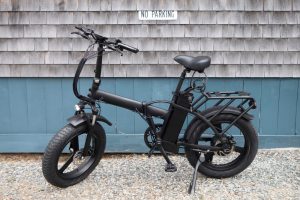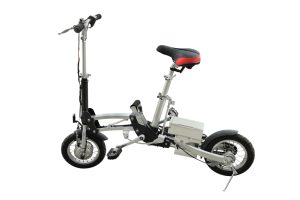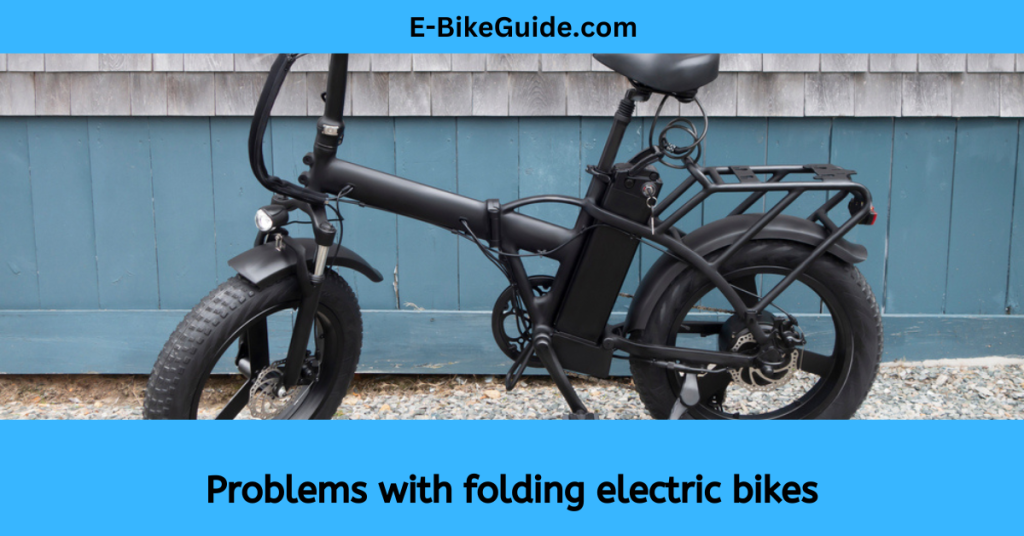Some people might find it a hassle, while others would find it ideal for riding a folding bike.
Some drawbacks are immediately apparent on paper, and some may only become apparent once you’ve dealt with them in practice.
Here are the major drawbacks of folding bicycles to give you an idea of what you’re getting into. This is driven by personal experience riding on a folding bicycle for almost a year in all types of conditions, as well as on discussions and letters with other bikers.
Expensive compared to standard bicycles of comparable quality

You should expect to pay an extra $100-$300 for a foldable bicycle with equivalent parts and construction to a standard bike. This is largely due to the high cost of developing and manufacturing a sturdy folding chassis.
For instance, standard bicycles with reasonable starting prices can be had for about $400 or $500. Take a look at these sample budgets to get a feel for what kind of numbers you should aim for.
However, a decent folding bike will save you at least $600–$700.
Similar to the $800 price tag, some standard bikes include commuter-friendly additions like dynamo lights. A folding bike with comparable features would cost at least $1,500.
The issue is whether or not the added expense is justified. If that fee gets you on your bike when you wouldn’t be able to ride otherwise, then that’s money well spent.
Bikes that fold up tend to cost more than their non-folding counterparts. You’ll need to shell out a little more cash to have a bike that folds up like a sheet of paper.
Overall, a rougher ride
One benefit of larger wheels is smoother riding over uneven terrain. The standard wheel size for folding bikes is 16 inches or 20 inches, whereas most race, hybrid, and road bikes utilize 27.5 inches or 29 inches. Because their wheels are only about two-thirds as wide, they experience bumps and other disturbances as being about as big as or as sudden as they are.
In addition, tires that are wider and more resistant to bumps are uncommon. There are a few notable exceptions, and they’re not exactly low-priced, feather-light, or space-efficient.
On well-kept roadways, this shouldn’t be an issue. However, if the pavement is more uneven, you might want wider tires. To make that statement, hybrid bikes win out over foldable ones.
Some manufacturers soften the ride with a stabilization block (integrated into the chassis) or a cushion Seatpost. Still, potholes are a concern, so be wary of them (and of “puddles” that might be liquid potholes) and drive carefully around them.
The upshot, though, is improved agility. While it’s not fun to go up and down curbs with 16 “-20” wheels, they make it much easier to get around the tight places you’ll encounter on a regular city commute.
Also, several problems arise when riding long distances on a foldable bike because of the shorter wheelbase.
After sitting for a while, the vibration above and bumpiness might become extremely tiring.
Simply put, wheels with a smaller diameter don’t maintain speed, too, though. The difference is insignificant for normal riding conditions. But after hundreds of kilometers, that extra work (we’ll guess 3% to 5%) adds up.
Being bumpy

Since shorter wheels need to spin quicker to get the same velocity, you will need to change tires more frequently. It isn’t a big deal to replace the tires each year or two rather than every four, so it’s not an issue for regular usage (for instance). However, if you’re going on tour, you’ll need to budget for more work and spare parts.
I have experience that the riding quality on folding bicycles could be smoother and more flexible than on other types of bicycles. Tire size is the primary factor in this explanation.
Wheel sizes on folding bikes range from 10 inches up to 26 inches. Common tire sizes for folding bicycles are 16, 20, and 24 inches.
The ride quality may be compromised due to the smaller wheels’ inability to absorb shock and larger ones. I recommend something other than folding bikes if you want a buttery ride. Neither your fat-tire cruiser nor your full-suspension mountain bike will have the same level of comfort.
Steep climbs are difficult to climb with a restricted gear choice.
The front sprocket is an unusual feature on folding bicycles. That’s partly because most commuting and city cyclists wouldn’t need a big gear spectrum and partly because it would make the fold more complicated.
But if you know, you’ll be facing some seriously steep hills. You could start wishing you had a “granny speed” up front.
For this reason, several manufacturers have introduced solutions such as relocating the entire gear or employing larger-than-usual increments between gears.
There are a few outliers, but you won’t find the vast gear range and little steps that a standard bike offers.
Hinges reduce durability and rigidity.

Folding bicycles can only support a fraction of the weight of regular bikes. Frame flex and loading limit are reduced when using hinges since the force is concentrated at a few spots rather than spread out along the tube.
You won’t notice this if you’re cycling within the legal limit and not pushing yourself too hard.
When sprinting hard, though, the flex could become obvious.
Most notably, certain folding bicycles are not suitable for heavier riders. It would help if you verified with the maker, but this list I made should get you started on the right track with several common models.
Transport constraints
Less space is available for luggage/cargo due to weight restrictions, an unconventional frame construction, and the inability to fold.
Common accessories, such as panniers installed on the fork, are frequently inaccessible. Bags on the saddle or handlebars could cause problems if folded in.
However, as the saying goes, “requirement is the parent of creativity,” I am often impressed by the ingenious methods by which individuals manage to load heavy objects onto their bicycles. (Be aware of the conditions of your guarantee!)
Some cargo bikes are so small that they may be folded up; for example, a Tern electric model can be folded up to fit in a closet. Tern is an interesting brand that is always looking for ways to make bicycles even more helpful (here’s more information on them), so while they aren’t nearly as compact, they are still worth looking into.
Somewhat more weight is present.

Hinge assemblies also necessitate substantial amounts of metal for support and longevity. That adds some heft if just a pound or two.
I think the difference in weight is so negligible that it is nearly moot for commuting and casual cyclists.
Please remember that getting a folding bike down to the low 20s in weight is challenging (and expensive!).
The lack of available handlebar alternatives compromises comfort.
Bicycles with handlebars that swoop back towards the rider are the most ergonomic. This helps you maintain a healthy wrist position when sitting up straight.
Their non-foldable form is a major drawback. As a result, the handlebars on most folding bikes are quite straight and only bend backward by a small amount.
To illustrate, the convenience of storing the folding Brompton would be compromised by adding a swept-back handlebar, as shown below.
However, many riders report that they are just fine, particularly for the short ranges we often cover when using foldable bikes.
You will feel at home over most foldable bikes if you are in the position of a standard hybrid cycle.
Doing otherwise may lead to ergonomic issues.
They have different hip appeals.

Okay, I’ll say it.
While I love my folding bike and ride it almost every day, I will be the first to say they are visually weird.
It’s not so much the bike itself as how well it fits the user. The greater the rider’s size, the more out of place the bicycle appears.
Is that a genuine concern? How does that impact their value and use? Does this have any bearing on your decision to purchase one?
Nope.
You won’t get any fashion points for it, but if you’re out in the clean air with your own time, you don’t care about things like that.
Because of the battery’s short lifespan
Your e-bike would only be complete with the battery. As a result, electric motorcycles have various drawbacks, one of which is limiting battery life.
The energy is present in batteries, which are then released to the engine, which ultimately helps you paddle more efficiently. It’s available in various wattages, from 250 to 500 to 750. You’ll need a permit if you want to use a battery with more power than the 750 watts allowed by the category 1-3 system.
A well-cared-for battery may power an electric bicycle for anything from two to five years. Even while not in use, battery packs gradually lose a few of their original capacity. Within a year, there was a 10% drop in efficiency.
As a result of this drawback, reduced performance, you will notice less help when riding and will have to put up more work than usual to conquer The Hills.
The number of times a battery determines how long it will last. It is one charge cycle when the battery is fully charged and then completely discharged. An electric bicycle battery from a reputable manufacturer should withstand at least a thousand charges.
Use of batteries

Compared to their lead-acid predecessors, lithium-ion batteries also have a much longer life (about 300 rotations).
Yet, the company’s development is important. Generally, a high-quality lead-acid battery will last longer than a low-quality Battery pack.
An e-bike battery may encounter problems, including overheating, rapid drain, and subpar functionality. Checking the E-bike battery’s guarantee is a must. In this case, you should choose a device with a guarantee of at least two years.
The price of the battery packs is high
The weight of an e-bike battery can vary from 360 to 1215 grams ($445.00 to $2,500.00) based on its performance and manufacturer. In this pricing range, one could see E-bike cells with a performance range ranging from 400 kW to more than 1000 kW. The premium price tag of the name-brand battery pack is justified by its superior construction and performance.
Slow battery charging time
The variables are the battery’s size and the chargers you’re using when it comes to how long your e-battery bicycle takes to charge. Nonetheless, a completely exhausted 500 Kw battery often takes close to 5 hours to charge to full capacity fully.
Using a regular charger, a 300 kW battery will take 2.5 hours to recharge, while a 1000 kW twin battery configuration will take approximately 9 hours. Furthermore, if you use a tiny charger, you will have to wait for nearly twice the time needed for a conventional charger.
Time

Now picture this: you have an important appointment in 30 mins, but you realize that you neglected to charge the battery in the e-bike since the last time you used it. What might you think about that?
Things can go even worse. Suppose you are out on an e-bike, and you need to remember to keep checking on your charge percentage when you run out of juice in the middle of nowhere. Completely feasible.
E-bike charging spots are accessible in several places, but their quantities are far from the gas stations for fossil fuel automobiles. For the time being, however, electric bikes have the disadvantage of needing to be charged for an extended period.
There will be a shift in the nearish term. The global demand for electric bicycles is rising, but until then, cyclists will have to learn to deal with this obstacle independently.
We can use these for short distances
Various variables affect an E-range bike, including the rider’s size, the topography (flat vs. hilly), the level of assistance used, and the type of road surface.
While many cyclists may find that an e-limited bike’s range is ideal, it is a drawback for others.
Planning is essential if you want to go for more than 40 miles (64 km) without pedalling a heavy bike (at least 44 pounds, 20 kilograms) because your battery ran out of juice.
It’s not cheap to provide maintenance and fixes:

How often, where, how, what parts you replace, and what kind of e-bike you pedal affect the cost and difficulty of repairs and maintenance.
The average annual cost of maintaining an e-bike is around $150 (121 pounds), with the average rider spending about the same amount on parts. So, it’s a sum of $300 (242 pounds) again for Routine maintenance of the e-bike.
Electronic bicycle repair shops are scarcer than traditional bicycle repair businesses.
The proprietors of the neighborhood businesses would rather sell you something new than fix the item you bought elsewhere. This adds to the growing number of drawbacks associated with electric motorcycles.
E-bikes have little resale value:
If you have a high-quality e-bike from a reputable manufacturer but in good shape, you could recoup as much as 50 percent of your initial investment. Most of the time, the resale price of an electric bicycle is far lower than the actual purchase price.
If you’re going to buy a secondhand electric bike, you should expect to have to purchase new batteries.
Conclusion

The compact folding design of this bike is a nice bonus. It weighs a relatively light 52 pounds. This bike has many features, including a twist handlebar, three levels of pedal assistance, and a walk-assist function. Adjustments on the bike make it suitable for riders between 5’1″ and 5’9″. Some riders experienced engine and cell problems, which is common with electric bikes in general. Users have reported difficulties locating replacement components. Although cheap, this bike isn’t necessarily the safest choice due to reports of wheel lock-up.
